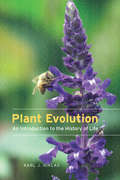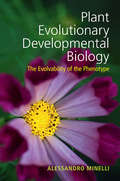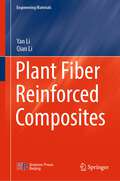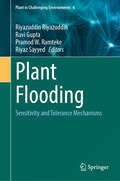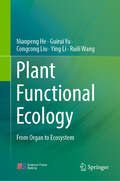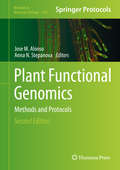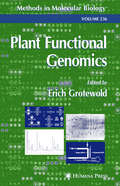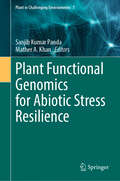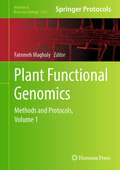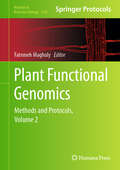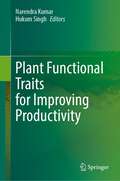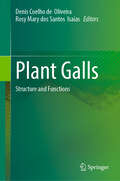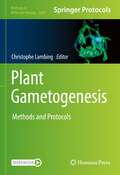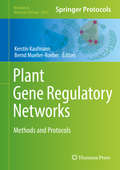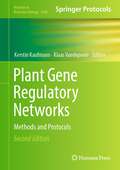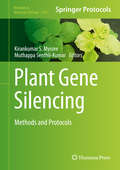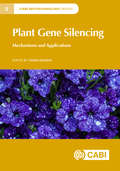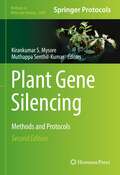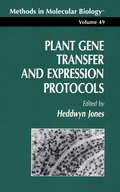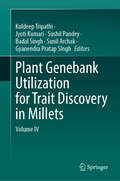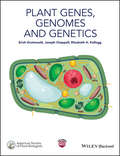- Table View
- List View
Plant Evolution: An Introduction to the History of Life
by Karl J. NiklasAlthough plants comprise more than 90% of all visible life, and land plants and algae collectively make up the most morphologically, physiologically, and ecologically diverse group of organisms on earth, books on evolution instead tend to focus on animals. This organismal bias has led to an incomplete and often erroneous understanding of evolutionary theory. Because plants grow and reproduce differently than animals, they have evolved differently, and generally accepted evolutionary views—as, for example, the standard models of speciation—often fail to hold when applied to them. Tapping such wide-ranging topics as genetics, gene regulatory networks, phenotype mapping, and multicellularity, as well as paleobotany, Karl J. Niklas’s Plant Evolution offers fresh insight into these differences. Following up on his landmark book The Evolutionary Biology of Plants—in which he drew on cutting-edge computer simulations that used plants as models to illuminate key evolutionary theories—Niklas incorporates data from more than a decade of new research in the flourishing field of molecular biology, conveying not only why the study of evolution is so important, but also why the study of plants is essential to our understanding of evolutionary processes. Niklas shows us that investigating the intricacies of plant development, the diversification of early vascular land plants, and larger patterns in plant evolution is not just a botanical pursuit: it is vital to our comprehension of the history of all life on this green planet.
Plant Evolutionary Developmental Biology: The Evolvability of the Phenotype
by Alessandro Minelli Maria Pia MannucciCompared to animals, plants have been largely neglected in evolutionary developmental biology. Mainstream research has focused on developmental genetics, while a rich body of knowledge in comparative morphology is still to be exploited. No integrated account is available. <P><P>In this volume, Minelli fills this gap using the same approach he gave to animals, revisiting traditional concepts and providing an articulated analysis of genetic and molecular data. Topics covered include leaf complexity and the evolution of flower organs, handedness, branching patterns, flower symmetry and synorganization, and less conventional topics such as fractal patterns of plant organization. Also discussed is the hitherto neglected topic of the evolvability of temporal phenotypes like a plant's annual, biennial or perennial life cycle, flowering time and the timing of abscission of flower organs. This will be informative reading for anyone in the field of plant evo-devo, from students to lecturers and researchers.
Plant Fiber Reinforced Composites (Engineering Materials)
by Yan Li Qian LiThis book comprehensively and systematically introduces the microstructure characteristics of plant fibers and the manufacturing process, interface characteristics, mechanical behaviors and physical properties of plant fiber reinforced composites, as well as their engineering demonstration applications. Plant fibers derived from natural resources have been thrust into the global spotlight as environment-friendly materials with attractive advantages of renewability, biodegradability, high specific strength and modulus and good sound absorption and heat insulation performance, and have become promising alternative to traditional synthetic fibers in making fiber-reinforced composites with structure-function integration. This book combines the basic theory with engineering applications for highlighting the unique research method for plant fiber reinforced composites with hierarchical structure. It is intended for undergraduate and graduate students who are interested in natural fiber composites, and scientific researchers and engineers looking to develop the design and manufacture of green composites in the fields of aerospace, railway transportation vehicles, automotive engineering and civil infrastructures.
Plant Flooding: Sensitivity and Tolerance Mechanisms (Plant in Challenging Environments #6)
by Ravi Gupta Pramod W. Ramteke Riyaz Sayyed Riyazuddin RiyazuddinThe issue of flooding has become a significant challenge on a global scale especially in rain-fed ecosystems, having soils with poor drainage. This significantly diminishes crop yield. Therefore, it is imperative to address the issue of flood stress, including the potential strategies for mitigating its adverse effects on crop yield, in order to ensure the continued provision of food for the growing global population. This book aims at bringing out a comprehensive collection of information on flooding stress on plants such as morphological, physiological, and molecular responses of plants to flood stress, omics studies to understand the molecular mechanism underlying flooding stress tolerance, and transgenic and microbial strategies to overcome flood stress. It also deals with the use of new technologies to understand flood stress and plant responses. The chapters included in this book are the compilation of latest information and data on the flood stress, its effect on the physiology, growth, and development of crop plants as well as mechanisms adapted by plants to overcome this stress. This book will help Researchers, Professors, Agri-Entrepreneurs, and Technologists understand the detrimental effects of flood stress, to develop newer approaches to mitigate flood stress. The book will help fill in designing new dimensions in the Flood Stress research and development of methods and technologies to overcome the flood-induced losses in crop yield.
Plant Functional Ecology: From Organ to Ecosystem
by Ying Li Ruili Wang Nianpeng He Guirui Yu Congcong LiuThis book provides a comprehensive exploration of plant functional traits and their critical role in understanding and predicting ecosystem functions in response to environmental changes. By bridging the gap between traditional ecological research and emerging macro-ecological technologies, this book offers an in-depth understanding of how functional traits at various levels, from organs to entire ecosystems, can be utilized to address complex ecological challenges, including global change. The chapters cover a wide range of topics essential to the field of ecology, including the development and application of plant functional traits, the scaling of traits from individual plants to communities, and the integration of these traits into advanced models and remote sensing technologies. Novel frameworks, such as plant community traits, ecosystem traits (ESTs), and plant trait networks (PTNs) are discussed, providing new ways to link species-level traits with ecosystem processes. These concepts are pivotal in expanding the application of trait-based ecology, allowing for more accurate predictions of ecosystem productivity, community assembly, and biodiversity patterns on a regional and global scale. The book also addresses the challenge of linking leaf and root traits to ecosystem functions, offering insights into how these traits can be scaled up and used to understand the adaptation strategies of plants in complex environments. Targeted at undergraduate and graduate students and researchers in ecology, this book is ideal for those seeking both fundamental and advanced knowledge of trait-based research in ecology. Offering valuable insights and practical frameworks that are essential for tackling the ecological challenges, the book is a must-read for anyone interested in the integration of macroecology, geography, and remote sensing to solve current regional ecological problems and global change.
Plant Functional Genomics
by Jose M. Alonso Anna N. StepanovaThis second edition volume discusses the revolutionary development of faster and less expensive DNA sequencing technologies from the past 10 years and focuses on general technologies that can be utilized by a wide array of plant biologists to address specific questions in their favorite model systems. This book is organized into five parts. Part I examines the tools and methods required for identifying epigenetic and conformational changes at the whole-genome level. Part II presents approaches used to determine key aspects of a gene's function, such as techniques used to identify and characterize gene regulatory networks. This is followed by a discussion of tools used to analyze the levels of mRNA, mRNA translation rates and metabolites. Part III features a compilation of forward and reverse genetic approaches that include recent implementation of high-throughput sequencing in classical methodologies such as QTL mapping. The final two parts explore strategies to facilitate and accelerate the generation and testing of functional DNA elements and basic computational tools used to facilitate the use of systems biology approached by a broad spectrum of plant researchers. Written in the highly successful Methods of Molecular Biology series format, chapters include introductions to their respective topics, lists of the necessary materials and reagents, step-by-step, readily reproducible laboratory protocols and key tips on troubleshooting and avoiding known pitfalls. Practical and timely, Plant Functional Genomics: Methods and Protocols, Second Edition highlights the latest developments in DNA sequencing technologies that are likely to continue shaping the future of functional genomics.
Plant Functional Genomics
by Erich GrotewoldErich Grotewold has assembled a team of leading plant scientists to describe in detail the most commonly used methods for investigating plant gene function in a wide variety of plants, during plant pathogen interactions, and even in algae. These readily reproducible protocols include computational, molecular, and genetic methodologies designed for both general and specific problems. Here the reader will learn about powerful computational and statistical tools to help predict gene function either on the basis of comparative genomics, or from the analysis of complex genome sequences. Numerous loss-of-function and gain-of-function techniques for discovering gene function are presented in step-by-step detail.
Plant Functional Genomics for Abiotic Stress Resilience (Plant in Challenging Environments #7)
by Sanjib Kumar Panda Mather A. KhanThe book provides a comprehensive overview of the functional genomics to develop a stress resilience crop. The book will be helpful to students doing their Master's, Ph.D., postdoc, and the scientific community in the fields of molecular biology, biotechnology, and crop improvement. The individual chapters of the proposed book will demonstrate a comprehensive understanding of the molecular mechanism, which is yet to be characterized for improving stress tolerance. Abiotic stresses such as drought, high soil salinity, heat, cold, oxidative stress, and heavy metal toxicity are common adverse environmental conditions that affect and limit crop productivity worldwide. Understanding the molecular basis of plant response to these environmental conditions has been a major focus of recent research. Abiotic stress is a complex trait, which is governed by multiple genes, i.e., "Functional Genomics", which aims to identify genes and determine their functions. Plant functional genome analysis has progressed to a high-throughput stage. The various parameters for developing abiotic stress resilience plants can be studied using transcriptomics, proteomics, metabolomics, and phenomics (OMICS). As a result, the study of functional genomics is critical in the development of crop production and meeting the demands of the world's ever-increasing population. This book is aimed at students, teachers, and scientists in academia and relevant private companies who are interested in the fields of crop improvement, horticulture, genetics, breeding, physiology, molecular genetics, genomics, in vitro culture and genetic engineering, and structural functional genomics. Specially, this book is intended to provide a comprehensive understanding of plant stress tolerance, with a focus on abiotic stress resilience, in order to improve crop yield. The primary audience for this book includes those seeking to deepen their knowledge of the biological process underlying plant stress tolerance and to apply this knowledge to the development of novel strategies for enhancing crop productivity.
Plant Functional Genomics: Methods and Protocols, Volume 1 (Methods in Molecular Biology #2787)
by Fatemeh MaghulyThis detailed book gathers hands-on techniques to characterize, identify, localize, profile, and determine genome functions in plants. Volume 1 opens with a section exploring protocols to advance our understanding of plant genetics and ecology via phenomics, and it continues with chapters on plant genetics, transcriptomics, and proteomics to unravel plant protein structures and functions, bridging proteomics and phosphoproteomics. Written for the highly successful Methods in Molecular Biology series, chapters include introductions to their respective topics, lists of the necessary materials and reagents, step-by-step and readily reproducible laboratory protocols, and tips on troubleshooting and avoiding known pitfalls. Authoritative and comprehensive, Plant Functional Genomics: Methods and Protocols serves as an ideal guide to the immense promise of functional genomics, spanning from fundamental evolutionary studies to practical advancements in crop improvement.
Plant Functional Genomics: Methods and Protocols, Volume 2 (Methods in Molecular Biology #2788)
by Fatemeh MaghulyThis detailed book gathers hands-on techniques to characterize, identify, localize, profile, and determine genome functions in plants. Volume 2 opens with metabolomic methods that uncover chemical intricacies, exploring glycome mixtures, cell wall components, and computational metabolomics, and it continues with sections on plant genome validation, computational approaches and bioinformatic tools, and case studies exploring the biological effects of magnetic fields and the study of cyanobacteria. Written for the highly successful Methods in Molecular Biology series, chapters include introductions to their respective topics, lists of the necessary materials and reagents, step-by-step and readily reproducible laboratory protocols, and tips on troubleshooting and avoiding known pitfalls. Authoritative and comprehensive, Plant Functional Genomics: Methods and Protocols serves as an ideal guide to the immense promise of functional genomics, spanning from fundamental evolutionary studies to practical advancements in crop improvement.
Plant Functional Traits for Improving Productivity
by Narendra Kumar Hukum SinghThis book discusses how plant functional trait selection can help researchers to understand the plant-environment relationship, identify desirable traits, modulate plant resilience according to the changing climate, optimize resource use efficiency, and enhance genetic improvement. The plant functional traits-based approach provides a framework for improving crop productivity in agricultural systems with high precision. It enables researchers to develop crop varieties with desirable traits by focusing on the fundamental characteristics influencing growth, development, and response. Climate change and environmental variability pose significant agricultural challenges. The plant functional traits-based approach can help address these challenges by selecting and breeding traits that enhance resilience and adaptability capacity of the plant. This approach also contributes to sustainable agriculture, by focusing on increased food production, and resilience in extreme environmental conditions. This book provides guidance to the researchers and breeders to develop crop varieties with desirable traits. It is also a reference book for graduate and postgraduate students studying botany and agriculture.
Plant Fungal Pathogens
by Melvin D. Bolton Bart P.H.J. ThommaOver the course of evolution, fungi have adapted to occupy specific niches, from symbiotically inhabiting the flora of the intestinal tract of mammals to saprophytic growth on leaf litter resting on the forest floor. In Plant Fungal Pathogens: Methods and Protocols, expert researchers in the field detail many of the methods which are now commonly used to study fungal plant pathogens. These include methods and techniques for model systems such as Arabidopsis thaliana as well as crop plants, aspects of fungal biology, genome annotation, next-generation sequencing, and fungal transformation and molecular tools for disease and/or pathogen quantification that are critical for revealing the role for a fungal gene of interest in disease development. Written in the highly successful Methods in Molecular BiologyTM series format, chapters include introductions to their respective topics, lists of the necessary materials and reagents, step-by-step, readily reproducible laboratory protocols, and key tips on troubleshooting and avoiding known pitfalls. Authoritative and practical, Plant Fungal Pathogens: Methods and Protocols seeks to aid scientists in the further study in current techniques that cover a wide-range of methods to study molecular aspects of pathogenesis.
Plant Galls: Structure and Functions
by Denis Coelho de Oliveira Rosy Mary dos Santos IsaiasThis book provides topics on gall development, chemistry, and physiology focusing on galls from different parts of the world. The chapters are devoted to get together basic knowledge and novelties on plant responses to the stimuli of diverse gall inducers, on cell, tissue, and organism levels. The information contained in this volume will set lights on crucial points that together explain how the plant-gall inducer interactions establish and are successful in different natural environments.
Plant Gametogenesis: Methods and Protocols (Methods in Molecular Biology #2484)
by Christophe LambingThis volume provides protocols and methods on techniques to study plant gametogenesis. Chapters are divided into four sections covering omics, cytological, molecular approaches, plant transformation, genome editing, bioinformatics, and data analysis. Written in the format of the highly successful Methods in Molecular Biology series, each chapter includes an introduction to the topic, lists necessary materials and reagents, includes tips on troubleshooting and known pitfalls, and step-by-step, readily reproducible protocols. Authoritative and cutting-edge, Plant Gametogenesis: Methods and Protocols aims to be a foundation for future studies and to be a source of inspiration for new investigations in the field.
Plant Gene Containment
by Melvin J. Oliver Yi LiGene Containment provides a comprehensive look at genetically modified organisms and the strategies and implementation of key methods to gene containment. The book is divided into 5 parts: An Introduction that discusses the need for biotechnology and GMOs, Section 1 looks at the need for gene containment, Part II discusses varying strategies for gene containment, section III explores the assessment of gene containment approaches, and section IV covers the steps involved in implementing gene containment. Gene Containment will provide a thorough and up to date look at gene containment research and the needs for implementing new strategies in this arena.
Plant Gene Regulatory Networks
by Kerstin Kaufmann Bernd Mueller-RoeberThis volume presents protocols that analyze and explore gene regulatory networks (GRNs) at different levels in plants. This book is divided into two parts: Part I introduces different experimental techniques used to study genes and their regulatory interactions in plants. Part II highlights different computational approaches used for the integration of experimental data and bioinformatics-based predictions of regulatory interactions. This part of the book also provides information on essential database resources that grant access to gene-regulatory and molecular interactions in different plant genomes, with a specific focus on Arabidopsis thaliana. Written in the highly successful Methods in Molecular Biology series format, chapters include introductions to their respective topics, lists of the necessary materials and reagents, step-by-step, readily reproducible laboratory protocols, and tips on troubleshooting and avoiding known pitfalls. Thorough and cutting-edge, Plant Gene Regulatory Networks: Methods and Protocols is a valuable resource for scientists and researchers interested in expanding their knowledge of GRNs.
Plant Gene Regulatory Networks: Methods and Protocols (Methods in Molecular Biology #2698)
by Kerstin Kaufmann Klaas VandepoeleThis second edition details protocols that analyze and explore gene regulatory networks (GRNs). Chapters guide readers through experimental techniques used to study genes and their regulatory interactions in plants, and computational approaches used for the integration of experimental data and bioinformatics-based predictions of regulatory interactions. Written in the format of the highly successful Methods in Molecular Biology series, each chapter includes an introduction to the topic, lists necessary materials and reagents, includes tips on troubleshooting and known pitfalls, and step-by-step, readily reproducible protocols. Authoritative and cutting-edge, Plant Gene Regulatory Networks: Methods and Protocols, Second Edition aims to be a useful and practical guide to new researchers and experts looking to expand their knowledge.
Plant Gene Silencing
by Kirankumar S. Mysore Muthappa Senthil-KumarThis volume provides readers with a comprehensive review of various gene silencing methodologies and its applications. It provides a historical overview of gene silencing mechanisms in plants, vectors, and strategies available for plant gene silencing, practical applications of gene silencing, bioinformatics tools, and other resources. In addition to these review chapters, this book includes methodology for virus-induced gene silencing (VIGS) in various different plant species, understanding plant stress responses using VIGS, miRNA identification, DNA interference, host-induced gene silencing, use of artificial miRNAs for gene silencing, high throughput RNAi, and more. Written in the highly successful Methods of Molecular Biology series format, chapters include introductions to their respective topics, lists of the necessary materials and reagents, step-by-step, readily reproducible laboratory protocols, and key tips on troubleshooting and avoiding known pitfalls. Thorough and practical, Plant Gene Silencing: Methods and Protocols seeks to aid scientists to further understand functional relevance of target genes using gene silencing methods and use these technologies in commercial plant varieties.
Plant Gene Silencing: Mechanisms and Applications
by Tamas DalmayPlant gene silencing is a crucially important phenomenon in gene expression and epigenetics. This book describes the way small RNA is produced and acts to silence genes, its likely origins in defence against viruses, and also its potential to improve plants. Plant gene silencing can be used to improve industrial traits, make plants more nutritious or more valuable to consumers, to remove allergens, and to improve resistance to weeds and pathogens
Plant Gene Silencing: Mechanisms and Applications (CABI Biotechnology Series)
by Sumit Ghosh Alberto Carbonell Heriberto Cerutti Soumita Das Asis Datta Emilie Elvira-Matelot John Fosu-Nyarko Juan Antonio Garcia Vincenza Ilardi Sadia Iqbal Michael G.K. Jones Eun-Jeong Kim Karl-Heinz Kogel Juan Jose Lopez-Moya Alessandra Lucioli Xinrong Ma Ángel Emilio Alba Ares Mingot Leandro Pena Elsa Pons Rosa M Ruiz-Vázquez Mario Tavassa Santiago Torres-Martinez Adrian Valli Herve Vaucheret Rahul Raj Singh Mohammad IrfanPlant gene silencing is a crucially important phenomenon in gene expression and epigenetics. This book describes the way small RNA is produced and acts to silence genes, its likely origins in defence against viruses, and also its potential to improve plants. Plant gene silencing can be used to improve industrial traits, make plants more nutritious or more valuable to consumers, to remove allergens, and to improve resistance to weeds and pathogens.
Plant Gene Silencing: Methods and Protocols (Methods in Molecular Biology #2408)
by Kirankumar S. Mysore Muthappa Senthil-KumarThis second edition provides a comprehensive review of various gene silencing methodologies and applications. Chapters detail a historical overview of gene silencing mechanisms in plants, vectors, and strategies available for plant gene silencing, practical applications of gene silencing, bioinformatics tools, and other resources. In addition to these review chapters, this book includes methodology for virus-induced gene silencing (VIGS), understanding plant stress responses using VIGS, miRNA identification, DNA interference, host-induced gene silencing, artificial miRNAs for gene silencing, and high throughput RNAi. Written in the format of the highly successful Methods in Molecular Biology series, each chapter includes an introduction to the topic, lists necessary materials and reagents, includes tips on troubleshooting and known pitfalls, and step-by-step, readily reproducible protocols. Authoritative and cutting-edge, Plant Gene Silencing: Methods and Protocols, Second Edition aims to further the understanding of functional relevance of target genes using gene silencing methods and technologies in commercial plant varieties.
Plant Gene Transfer and Expression Protocols
by Heddwyn JonesIn Plant Gene Transfer and Expression Protocols, leading experts present the latest step-by-step recipes for introducing genes into model and agricultural plants and for studying gene activity using reporter enzyme assays, RNA techniques, and immunological methods. The book contains not only a complete collection of "mainstream" methods, but also methods for studying gene expression and genetic manipulation in chloroplasts and mitochondria. There are also methods for introducing and analyzing plant genes in Xenopus and heterologous yeast hosts. Plant Gene Transfer and Expression Protocols is an indispensable tool for scientists working in both fundamental (biochemical, physiological, and genetic) and applied aspects of plant biotechnology, plant breeding, agriculture, and horticulture. It provides concise practical help that produces the desired results even for beginners and opens the doors to new research possibilities.
Plant Genebank Utilization for Trait Discovery in Millets: Volume IV
by Kuldeep Tripathi Jyoti Kumari Sushil Pandey Badal Singh Sunil Archak Gyanendra Pratap SInghThis book provides global information on utilization of plant genetic resources (PGRs) of major millets. It discusses various aspects such as genebank resources, valuation of germplasm, genomics-assisted trait discovery and their utilization for cultivar development. PGRs are the backbone of crop improvement program essential for reaching global food security. Millets are an important crop globally as they provide food security, nutrition, cultural significance, livelihoods, and environmental health security. Its promotion by the enhancement of area under cultivation and varietal development by efficient use of PGRs is the need of the hour. Hence, for sustainable production of millets, efficient use and management of millets' PGRs are equally important. Traditional methods of PGRs' management are being challenged by the ever-changing needs, priorities, climate, technologies, and policies. To address this issue of sustainable management of PGRs, there is a need to create awareness among the various stakeholders in a scientific manner covering all aspects from conservation to utilization. This book also discusses advances in tools and techniques used for phenotyping, genotyping, and genomic-assisted trait discovery in millet crops. The target audience for this book are research scholars, scientists and academicians involved in the field of utilization and conservation of PGRs. This book serves as a reference material to postgraduate students studying millet crops.
Plant Genes, Genomes and Genetics
by Erich Grotewold Elizabeth A. Kellogg Joseph ChappellPlant Genes, Genomes and Genetics provides comprehensive treatment of all aspects of plant gene expression. Unique in explaining the subject from a plant perspective, it highlights the importance of gene expression in how plants interface with the modern world, and notes the many aspects of gene expression that were first discovered in plants.This reference covers topics ranging from plant genome structure and the key control points in how genes are expressed, to the mechanisms by which proteins are generated and how their activities are controlled and altered by posttranslational modifications.Edited by authorities in the field, with contributions from invited experts, this textbook also includes:specific examples that highlight when and how plants operate differently from other organisms;special sections that provide in-depth discussions of particular issues;end-of-chapter problems to help students recapitulate the main concepts;full colour, with clear diagrams and illustrations showing important processes in plant gene expression;a companion website with PowerPoint slides, downloadable figures, and answers to the questions posed in the book.While primarily aimed at upper level undergraduates and graduate students in Plant Biology, this text is equally suited for advanced Agronomy and Crop Science students inclined to understand molecular aspects of organismalphenomena. It is invaluable for any professional entering the field of plant biology.
Plant Genetic Resources and Climate Change
by Michael Jackson Nigel Maxted William Erskine Helen Ougham Martin Parry Geoff Hawtin Sue Armstrong Andy Jarvis Salvatore Ceccarelli Ianto Thomas Kenneth Mcnally Ben Vosman Brian Ford-Lloyd Richard Betts Pam Berry Wayne Powell Robert Zeigler Mauricio Bellon Jeremy Pritchard Abdelbagi Ismail Pv Prasad Gerald Moore David Mackill John Sheehy Hari Upadhyaya Colette Broekgaarden Nora Castaneda Alvarez* Provides specific examples of germplasm research related to climate change threats * Edited by internationally renowned experts in the field * The final chapter of the book draws a synthesis of the many issues raised within the book
